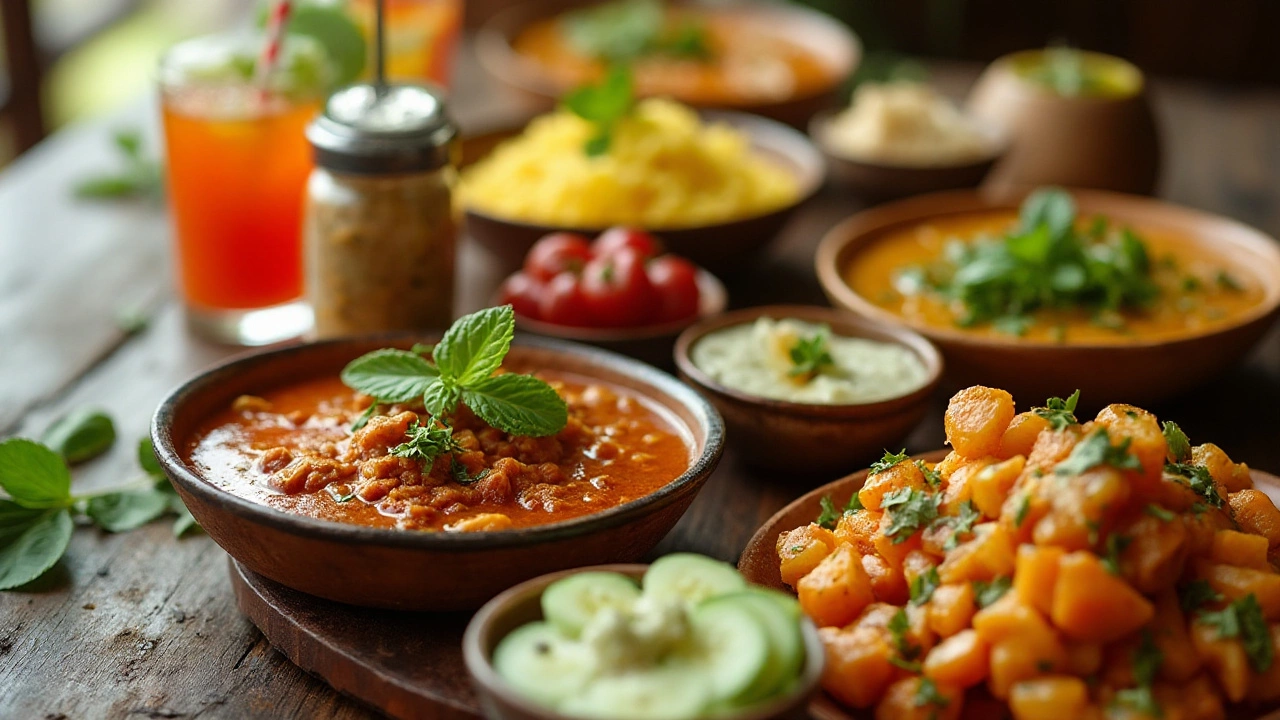
Recognizing and Managing High Pitta Symptoms in Ayurveda
In the ancient science of Ayurveda, balance is key to maintaining good health and harmony in life. One vital aspect is understanding the three doshas: Vata, Pitta, and Kapha. Among these, Pitta is primarily associated with fire and water elements, governing transformation processes in the body, including metabolism and digestion. When in balance, Pitta supports vitality and intelligence. However, an excess can lead to various disturbances both physically and mentally.
High Pitta can manifest in diverse ways, often felt as excessive body heat, skin issues, or sudden bursts of anger. Identifying these signs early can be beneficial. This article explores the nuances of high Pitta, offering insights into typical symptoms and practical advice on adjusting your habits to soothe and balance this fiery dosha. By adopting suitable changes in diet and lifestyle, one can effectively manage Pitta's intensity and foster a peaceful, healthier existence.
- Understanding Pitta Dosha
- Common Symptoms of High Pitta
- Dietary and Lifestyle Adjustments
- Natural Remedies and Tips
Understanding Pitta Dosha
The ancient wisdom of Ayurveda introduces us to the concept of pitta dosha, a vital component of the tridosha theory, which seeks to explain the unique constitutional make-up of an individual. The word 'pitta' stems from the Sanskrit root ‘tap’, which means heat. This dosha is represented by the dynamic fusion of the fire and water elements, embodying qualities such as hot, sharp, oily, light, and spreading. Pitta is pivotal in driving the body's metabolic processes, aiding in digestion and assimilation, and steering the mental faculties towards comprehension and sharpness.
According to an Ayurvedic classic, the Charaka Samhita, pitta is likened to the sun, illuminating the world and regulating time. This metaphor underscores its transformative and regulating nature. When in equilibrium, pitta ensures even digestion, regulated body temperature, and a sharp intellect. People with a dominant pitta experience a characteristic warm skin, high energy levels, and a natural leadership disposition. However, when this balance is skewed, the fiery nature of pitta can lead to symptoms like heartburn, skin rashes, and irritability, akin to overflowing molten lava.
Vasant Lad, a renowned figure in Ayurveda, once stated, "Pitta provides the body heat and digestion power; however, its surplus can manifest as burning emotions."Addressing imbalances in pitta starts with understanding its cyclical peaks during the day, seasons, and stages of life. Pitta individuals typically thrive in routines that cater to their balanced state, particularly favoring serene environments that counteract their fiery constitution. Engaging in calming activities like yoga or meditation can be beneficial.
In the natural cycle of time, pitta dominates from midday to early afternoon and again from midnight to early morning. Seasonally, it reaches its zenith during the summer months, the time when one must remain vigilant about dietary intake. Consuming fresh, cooling, and hydrating foods becomes essential. A common suggestion is to emphasize cooling and sweet-tasting foods which naturally pacify the pitta's fiery fervor.
For those eager to delve deeper, Ayurveda proposes that mental attributes such as ambition, willpower, and discernment are inextricably linked to pitta's influence. Individuals dominated by this dosha often drive innovation and can't help but inspire those around them. However, unchecked pitta can give rise to overwhelming emotions of jealousy and criticism. Understanding these varied dimensions assists in channeling pitta energies productively.
It's insightful to look at history, as many great leaders and pioneers display pitta characteristics. Their fiery determination fueled by pitta energy often brings about transformative changes. Yet, it's the balanced management of their inner fire that paves their journey towards greatness.
Let’s not forget the role of lifestyle factors in maintaining balance. Regular sleep, minimizing exposure to heat, and engaging in creative yet calming activities can play a huge role in balancing pitta. Listening to soothing music or spending time in nature might seem simple, but these practices hold transformative potential in managing pitta's potent energy.

Common Symptoms of High Pitta
Experiencing high pitta can feel like standing too close to a roaring fire. This dosha's fiery and intense nature manifests visibly in both our physical bodies and our emotional states. For those with elevated pitta, warmth is a common sensation. You might notice your skin feels warmer or your hands are always hot to the touch. Such heat leads to excessive sweating even when others around you are comfortable, hinting at an internal imbalance. Alongside this, inflammations become frequent visitors. Skin conditions like rashes, acne, or redness often flare up unexpectedly, clearly marking the Pitta turmoil within.
Digestive distress is another noteworthy symptom. Those wrestling with high pitta often grapple with acidity and heartburn. This is because Pitta governs the digestive fire, and when it's overactive, it can lead to a burning sensation in the stomach and throat. You may find spicy or fried foods unbearable, causing discomfort that disrupts day-to-day routines. A strong hunger and thirst are hallmark traits, but they come with drastic mood swings if meals are missed or delayed. The mind, too, bears the brunt of high Pitta, leading to irritability, impatience, and quick flares of anger at the slightest inconvenience. This emotional turbulence is often compounded with a competitive nature, pushing oneself to strive harder, sometimes at the cost of peace.
"When you're experiencing high Pitta, it's akin to driving a car with your foot constantly on the accelerator. It's exhilarating at times, but exhausting, and eventually, something's going to give," said Dr. David Frawley, an esteemed Ayurvedic scholar.
Rapid and eloquent speech, along with a sharp intellect, might be marked as positive traits associated with the Pitta dominion. However, these can also spiral into verbosity and arguments that leave relationships strained. Some individuals also notice a sensitivity to bright lights or the sun, often preferring the shade or dimly lit surroundings. High levels of Pitta can affect sleep, making one vulnerable to disturbed rest or often waking up between two and four in the morning. Understanding these symptoms holistically aids in self-awareness and is the first step towards restoring equilibrium with targeted lifestyle adjustments.
Attempting to quantify this isn't easy, but a study examining participants with high pitta tendencies notes increased occurrences of headaches and sinusitis. An interesting correlation has been found between Pitta imbalance and liver-related concerns owing to the dosha's affinity with bile production. Observing this, practitioners suggest regular detox practices and maintaining a cooling regimen for those frequently encountering these signals. By staying attentive to such changes, one can embark on a guided path toward better health and harmony.

Dietary and Lifestyle Adjustments
To tackle high pitta, it's crucial to incorporate dietary and lifestyle changes that counterbalance its fiery nature. One of the most effective strategies involves focusing on cooling foods, which can help soothe the excess heat within the body. Include an abundance of sweet, bitter, and astringent flavors in your diet as they are known to pacify pitta. Foods like cucumbers, melons, leafy greens, cherries, and basmati rice are excellent choices. They not only aid in cooling the body but also provide nourishment without aggravating pitta. Alongside these, it is advisable to avoid spicy, sour, salty, and fried foods, since they can further inflame pitta's fiery disposition.
Hydration plays a key role in keeping pitta in check, as staying adequately hydrated can help flush out toxins and prevent overheating. Sipping coconut water, herbal teas, and aloe vera juice can be particularly beneficial. Each of these beverages not only hydrates but also offers soothing and cooling effects to the system. Moreover, maintaining routine meal times is crucial, as irregular eating can disrupt digestion and lead to further pitta imbalance. A well-paced schedule with sufficient breaks for meals ensures the digestive systems function optimally.
On the lifestyle front, learning to manage stress effectively can significantly help in maintaining pitta balance. Engaging in calming activities like yoga, meditation, and deep-breathing exercises can reduce stress-induced flare-ups. Such practices help dissipate stress and encourage mental peace, which is vital for pacifying pitta. A regular sleep schedule is also essential, as erratic sleep patterns can exacerbate feelings of irritability and impatience.
Creating a serene living environment that promotes relaxation can also contribute immensely. Surround yourself with soothing colors like blues and greens, which are known to have calming effects. Additionally, incorporating the cooling properties of sandalwood or lavender in your daily routine, either as essential oils or in your bath, can provide further relief. According to Dr. Vasant Lad, a renowned expert in ayurvedic medicine, "Creating an external environment that mirrors the calmness and cooling needed internally can be transformative."
For those interested in a detailed dietary balance, the following table offers insights into foods to favor and avoid:
| Food Group | To Favor | To Avoid |
|---|---|---|
| Fruits | Pears, melons, sweet citrus | Sour berries, pineapples |
| Vegetables | Asparagus, cucumbers | Tomatoes, hot peppers |
| Grains | Basmati rice, oats | Corn, brown rice |
| Legumes | Black beans, chickpeas | Red lentils, mung beans |
Aligning your dietary and lifestyle habits with the principles of Ayurveda not only alleviates symptoms of high pitta but also promotes a sense of overall well-being. It's about listening to your body, assessing its needs, and making informed choices to support and nurture its natural state of balance.

Natural Remedies and Tips
Discovering ways to balance high pitta levels provides not just relief but a pathway to holistic well-being. One popular approach in Ayurveda involves adjusting your dietary habits. Cooling foods that naturally pacify pitta are recommended, such as sweet, bitter, and astringent flavors. These choices can include juicy fruits like pears and melons, and leafy greens, which replenish and hydrate the body without adding too much internal heat. Avoiding hot, spicy foods, as well as acidic and salty dishes, can prevent further aggravation.Pitta imbalances often manifest as skin issues or heat intolerance, making it crucial to work these cooling foods into daily meals.
Herbal remedies are also widely used in Ayurveda to balance pitta dosha. Herbs such as brahmi and amalaki are noted for their cooling and calming effects on both the body and mind. Brahmi can be particularly effective in easing stress and enhancing mental clarity, while amalaki, also known as Indian gooseberry, is an excellent source of Vitamin C and offers potent antioxidant properties. These herbs can be consumed in forms like teas or supplements. Regular use can help maintain healthy skin and digestion, two areas frequently impacted by high pitta.
Engaging in lifestyle modifications plays an equally vital role in managing high pitta. Incorporate daily practices such as meditative exercises or yoga, specifically focusing on calming techniques that emphasize breath control and grounding. Practicing yoga poses like the forward bend or child's pose can significantly reduce stress and cool down the pitta fire. Additionally, spending time in nature, particularly near water, can inherently pacify the fiery nature of pitta.
As the Ayurvedic teacher Maya Tiwari says, "The natural interplay of the mind and body...can be influenced by each individual stepping back and fully listening to the rhythms of the earth."
Establishing a consistent daily routine can help stabilize volatile pitta energies. This involves maintaining a balanced sleep schedule, ensuring you get adequate rest, since pitta-types often work incessantly, burning the candle at both ends. Over time, adopting consistent sleeping patterns ensures the body is cooled and refreshed. Emphasizing downtime in your routine aids in grounding and stabilizing heightened energies.
The key to managing high pitta effectively lies in understanding its root causes and regularly applying these natural strategies. By embracing changes that encourage a cooler, calmer way of life, and choosing foods, herbs, and practices that balance pitta, you foster unity between your physical and mental well-being. This nurtures a more harmonious existence that adheres to both practices based on ancient wisdom and modern understanding of health.

Arnav Singh
I am a health expert with a focus on medicine-related topics in India. My work involves researching and writing articles that aim to inform and educate readers about health and wellness practices. I enjoy exploring the intersections of traditional and modern medicine and how they impact healthcare in the Indian context. Writing for various health magazines and platforms allows me to share my insights with a wider audience.
About
Medical Resource Center India is a comprehensive online platform dedicated to providing reliable health information and medical resources in India. Explore a wide range of articles, tips, and advice on medicine, healthcare services, and wellness. Stay informed about the latest developments in Indian medicine and access valuable insights into maintaining a healthy lifestyle. Discover expert guidance and health solutions tailored for every Indian citizen. Your go-to destination for authoritative medical knowledge in India.







